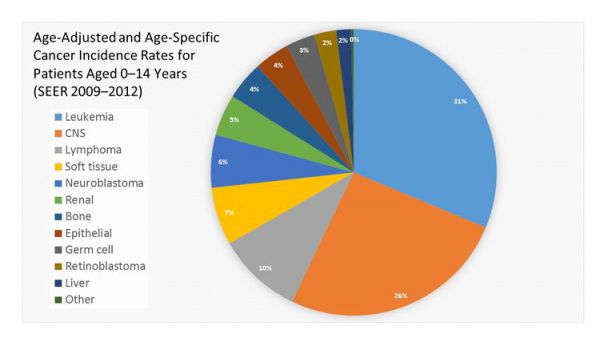Types/childhood-cancers/hp/unusual-cancers-childhood-pdq
Rare Cancers of Childhood Treatment
General Information About Rare Cancers of Childhood
In This Section
- Introduction
Introduction
Cancer in children and adolescents is rare, although the overall incidence of childhood cancer has been slowly increasing since 1975.[1] Referral to medical centers with multidisciplinary teams of cancer specialists experienced in treating cancers that occur in childhood and adolescence should be considered for children and adolescents with cancer. This multidisciplinary team approach incorporates the skills of the primary care physician, pediatric surgeons, radiation oncologists, pediatric medical oncologists/hematologists, rehabilitation specialists, pediatric nurse specialists, social workers, and others to ensure that children receive treatment, supportive care, and rehabilitation that will achieve optimal survival and quality of life. (Refer to the PDQ Supportive and Palliative Care summaries for specific information about supportive care for children and adolescents with cancer.)
Guidelines for pediatric cancer centers and their role in the treatment of pediatric patients with cancer have been outlined by the American Academy of Pediatrics.[2] At these pediatric cancer centers, clinical trials are available for most types of cancer that occur in children and adolescents, and the opportunity to participate in these trials is offered to most patients and their families. Clinical trials for children and adolescents diagnosed with cancer are generally designed to compare potentially better therapy with therapy that is currently accepted as standard. Most of the progress made in identifying curative therapy for childhood cancers has been achieved through clinical trials. Information about ongoing clinical trials is available from the NCI website.
Dramatic improvements in survival have been achieved for children and adolescents with cancer. Between 1975 and 2010, childhood cancer mortality decreased by more than 50%.[3] Childhood and adolescent cancer survivors require close monitoring because cancer therapy side effects may persist or develop months or years after treatment. (Refer to the PDQ summary on Late Effects of Treatment for Childhood Cancer for specific information about the incidence, type, and monitoring of late effects in childhood and adolescent cancer survivors.)
Childhood cancer is a rare disease, with about 15,000 cases diagnosed annually in the United States in individuals younger than 20 years.[4] The U.S. Rare Diseases Act of 2002 defines a rare disease as one that affects populations smaller than 200,000 persons. Therefore, all pediatric cancers are considered rare.
The designation of a rare tumor is not uniform among pediatric and adult groups. Adult rare cancers are defined as those with an annual incidence of fewer than six cases per 100,000 people, and are estimated to account for up to 24% of all cancers diagnosed in the European Union and about 20% of all cancers diagnosed in the United States.[5,6] Also, the designation of a pediatric rare tumor is not uniform among international groups, as follows:
- The Italian cooperative project on rare pediatric tumors (Tumori Rari in Eta Pediatrica [TREP]) defines a pediatric rare tumor as one with an incidence of less than two cases per 1 million population per year and is not included in other clinical trials.[7]
- The Children's Oncology Group (COG) has opted to define rare pediatric cancers as those listed in the International Classification of Childhood Cancer subgroup XI, which includes thyroid cancer, melanoma and nonmelanoma skin cancers, and multiple types of carcinomas (e.g., adrenocortical carcinoma, nasopharyngeal carcinoma, and most adult-type carcinomas such as breast cancer, colorectal cancer, etc.).[8] These diagnoses account for about 4% of cancers diagnosed in children aged 0 to 14 years, compared with about 20% of cancers diagnosed in adolescents aged 15 to 19 years (refer to Figures 1 and 2).[9]
Most cancers within subgroup XI are either melanomas or thyroid cancer, with the remaining subgroup XI cancer types accounting for only 1.3% of cancers in children aged 0 to 14 years and 5.3% of cancers in adolescents aged 15 to 19 years.
These rare cancers are extremely challenging to study because of the low incidence of patients with any individual diagnosis, the predominance of rare cancers in the adolescent population, and the lack of clinical trials for adolescents with rare cancers such as melanoma.


Some investigators have used large databases, such as the Surveillance, Epidemiology, and End Results (SEER) and the National Cancer Database, to gain more insight into these rare childhood cancers. However, these database studies are limited. Several initiatives to study rare pediatric cancers have been developed by the COG and other international groups, including the International Society of Paediatric Oncology (Société Internationale D'Oncologie Pédiatrique [SIOP]). The Gesellschaft für Pädiatrische Onkologie und Hämatologie (GPOH) rare tumor project was founded in Germany in 2006.[10] The TREP was launched in 2000,[7] and the Polish Pediatric Rare Tumor Study Group was launched in 2002.[11] In Europe, the rare tumor studies groups from France, Germany, Italy, Poland, and the United Kingdom have joined in the European Cooperative study Group on Pediatric Rare Tumors (EXPeRT), focusing on international collaboration and analyses of specific rare tumor entities.[12] Within the COG, efforts have concentrated on increasing accrual to COG registries (Project Every Child) and tumor banking protocols, developing single-arm clinical trials, and increasing cooperation with adult cooperative group trials.[13] The accomplishments and challenges of this initiative have been described in detail.[8,14]
The tumors listed in this summary are very diverse; they are arranged in descending anatomic order, from infrequent tumors of the head and neck to rare tumors of the urogenital tract and skin. All of these cancers are rare enough that most pediatric hospitals might see less than a handful of some histologies in several years. The majority of the histologies listed here occur more frequently in adults. Information about these tumors may also be found in sources relevant to adults with cancer.
Enable comment auto-refresher